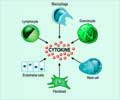A key step in an evolutionarily old branch of the immune response has been deciphered by researchers from the University of Pennsylvania and Utrecht University.

Molecular structure of the complement pro-convertase in complex with factor D. A double safety catch mechanism that involves a tiered and meticulously orchestrated interplay of three proteins (C3b, factor B, factor D) ensures that the destructive action of complement is restricted to target cells such as microbial intruders.
In a study, the groups of John Lambris, the Dr. Ralph and Sally Weaver Professor of Research Medicine at Penn, and Piet Gros at Utrecht, detail the atomic structure of two key transient enzyme complexes in the human complement system.
Complement proteins mark both bacterial and dying host cells for elimination by the body's cellular cleanup services and have been implicated in at least 30 diseases, including stroke, myocardial infarction, and age-related macular degeneration.
"Now we will be able to design specific complement inhibitors to target this complex and in that way inhibit activation of the complement cascade, because now we know which parts of the proteins are essential for activity," said Lambris.
The two enzyme complexes Lambris studied, called C3bB and C3bBD, drive a central step in amplifying the response by complement proteins.
Advertisement
Source-ANI












